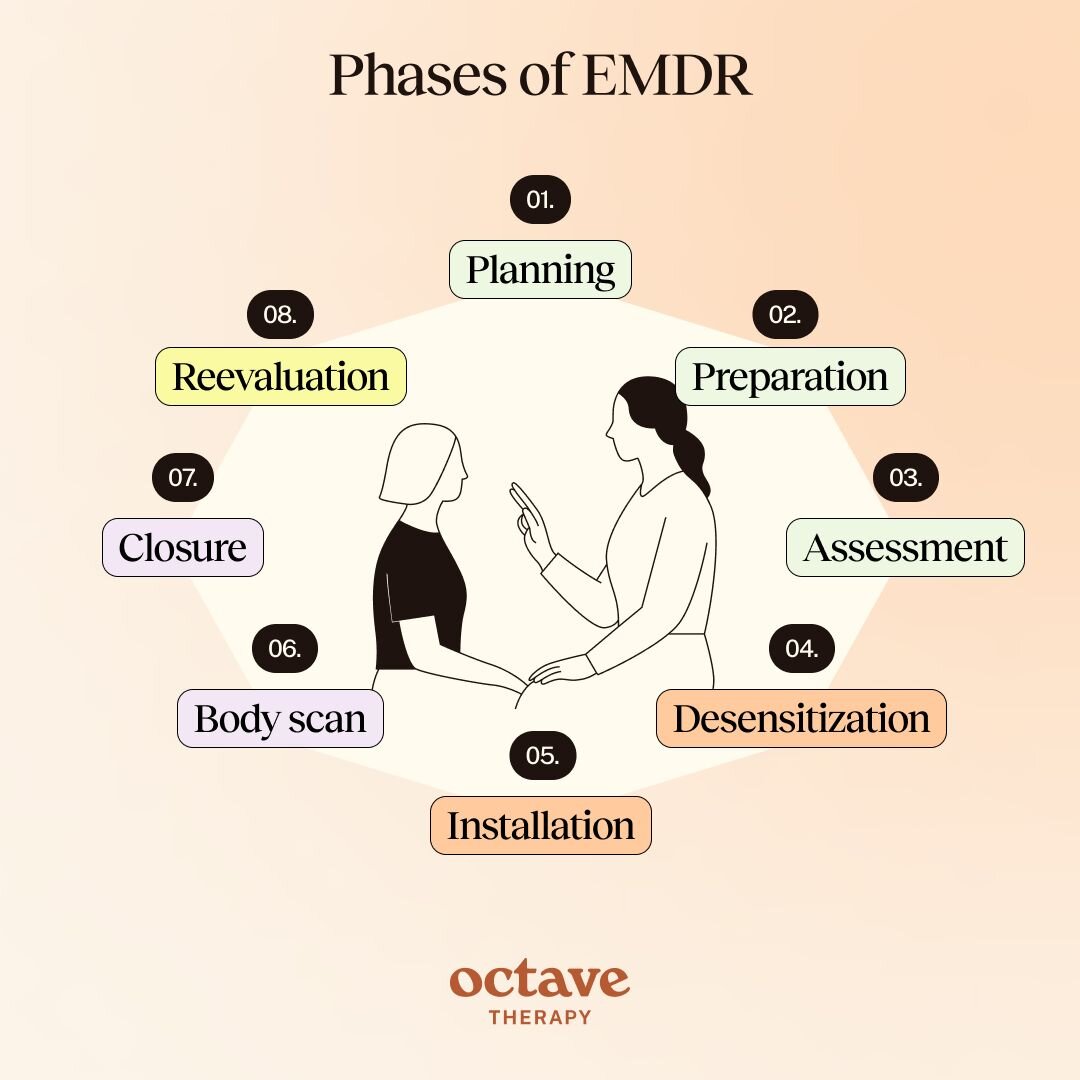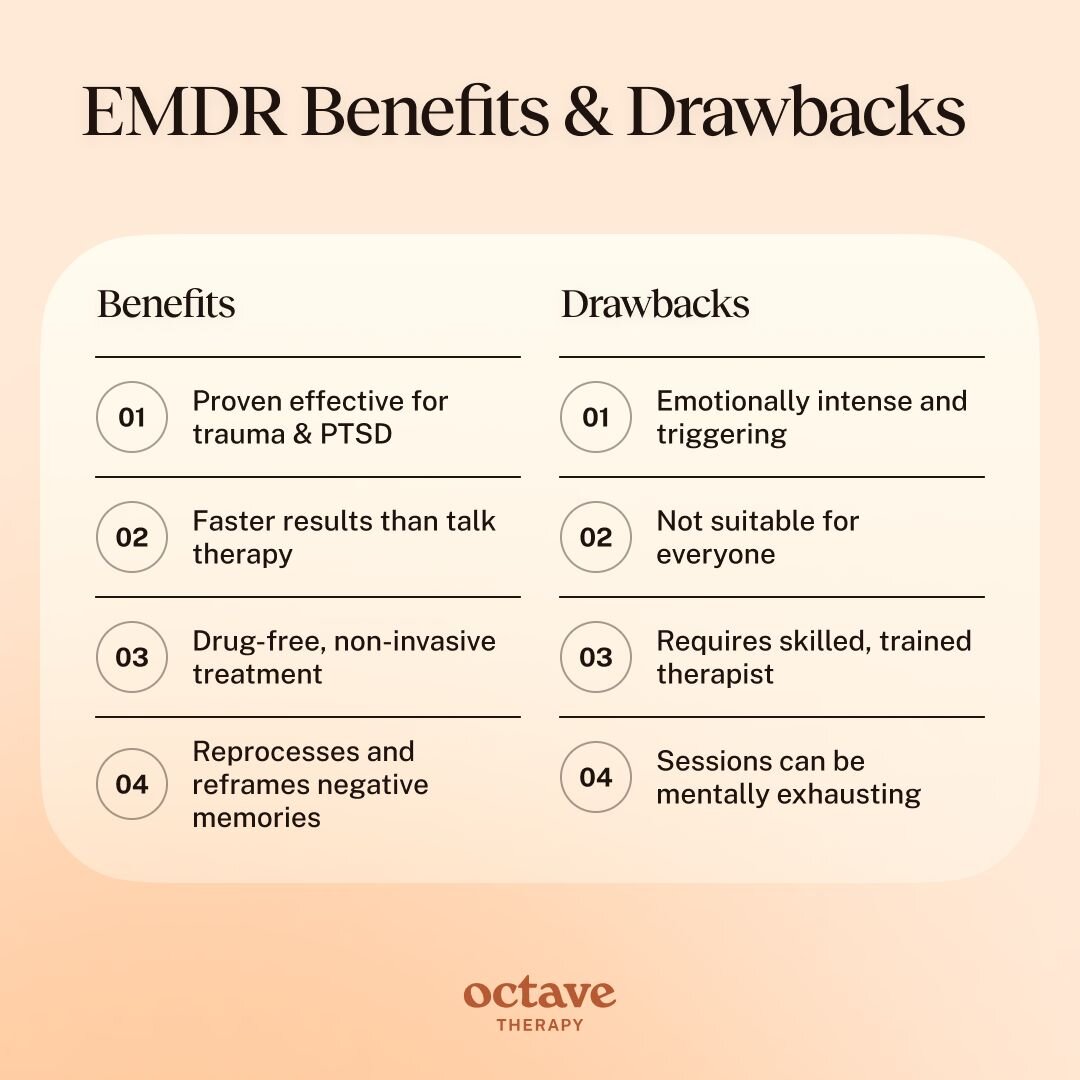
What is EMDR Therapy?
Overview
EMDR stands for “Eye Movement Desensitization and Reprocessing”. It helps people process and heal from traumatic memories. It can also help with activating memories, meaning memories that cause major emotional responses.
In an EMDR therapy session, you’ll recall the targeted memory while engaging in bilateral stimulation, which means stimulation that occurs on both sides of the body. This might be rapid eye movements, tapping, or listening to sounds. EMDR is an evidence-based approach that can help the brain reprocess the memory, making the emotional response to the memory more neutral.
How Does EMDR Therapy Work?
EMDR therapy is based on the belief that the mind can heal itself as the body does. Typically, when your brain processes memories, it stores them in a story format. But, when you experience a traumatic event or ongoing distress, sometimes these memories don’t get stored properly. Instead, they can become associated with emotions and physical sensations. This means that experiences that are similar to this memory can trigger emotions like anxiety, panic, and anger. With EMDR therapy, your brain reprocesses the memory so that it no longer triggers these intense emotions.
In EMDR therapy, you’ll recall a disturbing memory that you and your therapist have identified. While you do this, you’ll engage in bilateral stimulation, like quick side-to-side eye movements. This can help reduce strong emotions associated with the memory, leading to a more neutral outlook on the memory. Mixing memory with sensory inputs, like sight and touch, helps the brain heal and reprocess memories effectively. During an EMDR session, you might experience a change in thoughts, images, and feelings.
EMDR therapy differs from traditional therapy. Those methods usually focus on the emotions and thoughts linked to trauma. Instead, EMDR focuses specifically on a memory. By reprocessing this memory, you may notice other benefits, like reduced anxiety, improved self-esteem, and better emotional regulation.
The 8 Phases of EMDR Therapy
EMDR is a structured form of therapy, meaning that your therapist will guide you through 8 steps throughout your sessions. Each session lasts about an hour to 90 minutes. Sessions are usually once a week, but they can be done more frequently. The first two phases, history & treatment planning and preparation, are usually only done in the initial session.
1) History & Treatment Planning
During the first phase, your therapist will work with you to understand your history. They’ll ask questions about your goals and the traumatic memory, disturbing image, or bodily sensation that brought you in for treatment. Then, your therapist will develop a treatment plan to meet your goals. This treatment plan will include the frequency of the sessions.
2) Preparation
During the preparation phase, your therapist will tell you more about what EMDR is, how it works, and what to expect from treatment. They’ll help you learn ways to handle tough emotions that can arise through trauma, like deep breathing and meditation. If you have any questions about EMDR or your treatment, this is a great time to ask them so that you’re prepared for the next steps.
3) Assessment
During this phase, the memory to be reprocessed will be identified. The therapist will ask questions to help you access the event along with associated feelings, images, and sensations. They’ll also take a baseline measurement to identify how the memory impacts you, so that it’s easy to measure progress. EMDR therapists often use the Subjective Units of Disturbance (SUD) scale. This has you rank how disturbing you find the targeted memory on a scale of 0 to 10, with 0 being no disturbance and 10 being the most disturbing.
4) Desensitization
Desensitization, installation, and body scan take place right after each other. They are considered the reprocessing phase of EMDR. In the desensitization phase, you’ll think about the targeted memory. At the same time, you’ll participate in bilateral stimulation. For example, your therapist might have you follow a light or play sounds from speakers located on either side of your body. This continues until your SUD reaches 0 or 1. During this time, you might notice new feelings or images associated with the memory emerging.
5) Installation
After desensitization, the therapist will help you to associate a positive belief with the event until it feels true. This involves repeating a positive phrase, such as “I am safe now” or “I am worthy”.
6) Body Scan
In the body scan phase, your therapist will help you connect with how your body is feeling from head to toe. This will help you tell if you’re experiencing any negative thoughts or sensations. If there continues to be any discomfort, then the desensitization will be repeated until any negative sensations are gone.
7) Closure
The closure and revaluation phases are important to help close the session safely and prepare you for the next session. During the closure phase, your therapist will help you return to a calm state where you can get back to your daily activities.
8) Reevaluation
Reevaluation is how the next session opens. In this phase, your therapist will check in on your feelings about the traumatic memory. They will also ask if you’re experiencing any distressing thoughts. If you are continuing to experience distress, then you’ll continue to focus on desensitization for the memory targeted in previous sessions. If not, you’ll move on to the next memory.

Benefits and Drawbacks of EMDR Therapy
Like any type of therapy, EMDR works better for some people than others. In this section, we’ll cover the benefits and drawbacks of EMDR therapy to help you decide if it's right for you.
Benefits
EMDR can be effective in helping individuals recover from traumatic events. Specific benefits include:
- Effective for Trauma and Post-Traumatic Stress Disorder (PTSD): EMDR therapy is a proven method for treating trauma and PTSD. One study indicates that 3 sessions of EMDR therapy led to a reduction in symptoms for 84% of PTSD patients.
- Rapid Results: Compared to talk therapy, EMDR can improve symptoms faster. The EMDR International Association says it usually takes about 3 sessions to reprocess one trauma. There’s also less homework than other types of therapy, as most of the work is done in session.
- Non-Invasive & Drug-Free: EMDR can be a great option for those who wish to avoid prescription medication. Because it uses guided eye movements, tapping, or auditory cues, you’re also in control of the session and awake the entire time.
- Reprocesses Negative Memories: EMDR “rewires” the brain. This helps change how the body stores negative memories. As it result, it can reduce distressing emotions. It also doesn’t require you to talk about the traumatic memory in-depth.
- Addresses Root Causes: EMDR goes beyond just the symptoms of trauma. It targets the deep-rooted trauma that causes symptoms.
- Empowering & Self-Healing: Because EMDR allows you to process memories at your own pace, many clients find that it’s empowering. While your therapist is there to support you, they’ll only intervene if needed, allowing much of the process to be self-healing.
Did you know? EMDR isn’t just for PTSD. It can improve other conditions, including:
- Anxiety disorders, including generalized anxiety disorder, panic disorder, phobias, social anxiety/phobia, and performance anxiety.
- Depressive disorders, including major depressive disorder (MDD), persistent depressive disorder, and illness-related depression.
- Dissociative disorders, including dissociative identity disorder or amnesia, and depersonalization or derealization disorder.
- Eating disorders, including anorexia nervosa, bulimia nervosa, and binge-eating disorder.
- Obsessive-compulsive disorders, including obsessive-compulsive disorder (OCD), body dysmorphic disorder, and hoarding disorder.
- Grief and loss
- Addictions
- Pain, including phantom limb pain
- Low self-esteem or feelings of worthlessness
Drawbacks
Although EMDR has high success rates, it’s not for everyone. Here are some potential drawbacks of EMDR:
- Emotional Intensity: EMDR can bring relief, but it first brings up traumatic memories. Although this process is quick, it can sometimes cause distress. Some individuals may also experience increased anxiety or panic attacks.
- Not Suitable for Everyone: EMDR might not work well for people with severe dissociation, unmanaged psychosis, or certain neurological conditions. This is because EMDR may worsen their symptoms. Certain medications, like benzodiazepines and alpha blockers, can also interfere with EMDR’s effectiveness.
- Requires a Skilled Therapist: For EMDR to be effective, it's important to work with a skilled therapist. You’ll want to ensure that the therapist you work with has been properly trained in EMDR.
- Doesn’t Work for All Trauma Types: EMDR is particularly effective for individuals with a single trauma. For individuals with more complex traumas, EMDR may need to be modified.
- Sessions Can Be Exhausting: EMDR sessions can be tiring. They require you to visit past trauma, which can be emotionally and mentally draining. Sometimes, individuals may experience headaches or dizziness after sessions.
- Limited Research for Some Issues: EMDR works well for PTSD, but there’s less research about its effectiveness for other mental health conditions, like generalized anxiety disorder. EMDR started in 1987, so it’s a newer therapy. More research is needed to see how effective it is in some cases.

Research on EMDR Therapy
Overall, EMDR has been studied the most for individuals with PTSD and trauma.
One study showed that 100% of participants with single-trauma PTSD had no symptoms after 6 sessions of EMDR. Also, 77% of participants with multiple-trauma PTSD experienced the same results. Additional findings regarding EMDR therapy for trauma include:
- Veterans with combat-related PTSD showed better treatment results with EMDR than with biofeedback relaxation or clinical care.
- 15 months after undergoing EMDR for PTSD, individuals maintained their progress as much as those who hadn’t been diagnosed with PTSD.
- After 6 months, 75% of people with adult-onset trauma showed less PTSD and depression. This was compared to those taking a selective serotonin reuptake inhibitor (SSRI).
- Compared to a control group, adult female sexual assault victims saw a decrease in PTSD and depressive symptoms after four sessions of EMDR.
- A review of 24 randomized controlled studies showed that EMDR helped with emotional trauma and other difficult life experiences.
- EMDR showed a reduction in PTSD symptoms and diagnoses and was more effective than other trauma treatments.
There have also been some promising findings using EMDR for treating other psychological conditions. Here are some more details:
- In some studies, EMDR was found to help improve phobia and panic symptoms.
- When compared to a control, EMDR was more effective in reducing panic symptoms associated with phobias.
- EMDR therapy was found to help improve the quality of life for individuals living with depression.
- For cancer patients, EMDR therapy was found to help reduce PTSD and the impact of treatments.
- Women who received therapy alongside standard eating disorder treatment noticed a greater drop in negative body image thoughts.
- Individuals with OCD reported a reduction in symptoms after 2-3 sessions of EMDR.
- People with chronic alcohol dependency showed a greater reduction in alcohol craving when receiving EMDR therapy alongside regular treatment.
- People with chronic pain reported reduced pain, fewer negative emotions, and an improved ability to manage their pain after receiving EMDR therapy.
Although the results of these studies are promising, it’s important to remember that the research is still in its early stages. Larger studies will help to further understand the impact of EMDR therapy on various mental health conditions. Comparing EMDR therapy to common mental health treatments, like medication and cognitive-behavioral therapy (CBT), will help us understand how effective it is.

Find an EMDR Therapist with Octave
Octave’s filters allow you to find an EMDR therapist easily. You can adjust these filters to find an EMDR therapist in your location or who specializes in a certain area. The EMDR International Association also offers a directory of EMDR therapists.
When looking for an EMDR therapist, you’ll want to consider:
- Credentials: In addition to general licensing for mental health clinicians, you’ll want to check the therapist’s training in EMDR. The EMDR International Association offers accredited training programs. Basic training helps EMDR therapists treat single traumas, while advanced training prepares them for more complex trauma cases.
- Comfort level: It’s important that you feel safe when completing EMDR therapy. Make sure your therapist explains EMDR therapy to you clearly. This way, you can understand it and ask questions about the process. You’ll also want to ensure that they take the time to prepare you for the process with stress-management techniques.
- Experience: Besides credentials, check your therapist’s experience with EMDR. They should have treated people with similar traumas or conditions. For example, if you have a dissociative disorder, you’ll want to ensure that your therapist has experience working with individuals with dissociative disorders. This helps ensure you stay safe during treatment.
- Additional Skills: EMDR training matters, but your therapist should have other skills, too. This is especially true if you are seeking EMDR therapy for something other than PTSD. For example, if you have an anxiety disorder, then you might wish to look for a therapist who provides evidence-based psychotherapy, like CBT, alongside EMDR.
